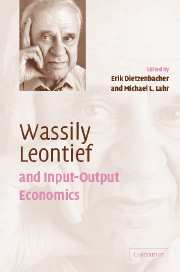Book contents
- Frontmatter
- Contents
- List of contributors
- List of figures
- List of tables
- Preface
- Part I Reflections on input-output economics
- Part II Perspectives of input-output economics
- 10 A neoclassical analysis of total factor productivity using input-output prices
- 11 What has happened to the Leontief Paradox?
- 12 The decline in labor compensation's share of GDP: a structural decomposition analysis for the United States, 1982 to 1997
- 13 An oligopoly model in a Leontief framework
- 14 Economies of plant scale and structural change
- 15 Technological change and accumulated capital: a dynamic decomposition of Japan's growth
- 16 Japan's economic growth and policy-making in the context of input-output models
- 17 Contributions of input-output analysis to the understanding of technological change: the information sector in the United States
- 18 How much can investment change trade patterns? An application of dynamic input-output models linked by international trade to an Italian policy question
- 19 Social cost in the Leontief environmental model: rules and limits to policy
- Subject index
- Author index
19 - Social cost in the Leontief environmental model: rules and limits to policy
Published online by Cambridge University Press: 22 September 2009
- Frontmatter
- Contents
- List of contributors
- List of figures
- List of tables
- Preface
- Part I Reflections on input-output economics
- Part II Perspectives of input-output economics
- 10 A neoclassical analysis of total factor productivity using input-output prices
- 11 What has happened to the Leontief Paradox?
- 12 The decline in labor compensation's share of GDP: a structural decomposition analysis for the United States, 1982 to 1997
- 13 An oligopoly model in a Leontief framework
- 14 Economies of plant scale and structural change
- 15 Technological change and accumulated capital: a dynamic decomposition of Japan's growth
- 16 Japan's economic growth and policy-making in the context of input-output models
- 17 Contributions of input-output analysis to the understanding of technological change: the information sector in the United States
- 18 How much can investment change trade patterns? An application of dynamic input-output models linked by international trade to an Italian policy question
- 19 Social cost in the Leontief environmental model: rules and limits to policy
- Subject index
- Author index
Summary
Introduction
Leontief was one of the first to address issues of social cost in an input-output context, proposing a particular model to deal with it (Leontief, 1970; Leontief and Ford, 1972). The basis of Leontief's environmental model (LEM for short) is a traditional open input-output model. His extension meant the introduction of coefficients representing the outputs of noxious substances and the introduction of specific anti-pollution processes or activities. Leontief formulated environmental policy in terms of a program aimed at reducing emissions into the environment. Abatement involved the operation of anti-pollution activities. Inputs to these new activities consisted of traditional goods (such as machinery, electronics or labor) and the – jointly produced and “free” – toxic substances. Outputs consisted of the elimination of the toxic substances. Thus, in Leontief's view, the “physical costs” of environmental policy were expressed as additional need for the traditional goods and labor, the model's primary factor.
How to address issues of social cost is an old problem. Many proposed solutions are based on a complex system of taxes and subsidies throughout the economy (e.g. Baumol and Oates, 1975). As such, they depend on detailed knowledge of the origin and type of pollution. Input-output analysis, with its focus on technology, therefore, is a good candidate for policy analysis in such cases. The development of the LEM, and subsequent work on it, illustrates this. However, many aspects, both of a theoretical and a practical nature, still need further investigation.
- Type
- Chapter
- Information
- Wassily Leontief and Input-Output Economics , pp. 367 - 386Publisher: Cambridge University PressPrint publication year: 2004
- 1
- Cited by



